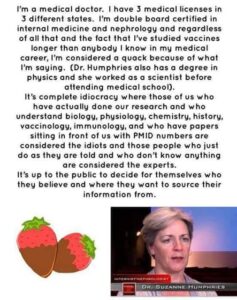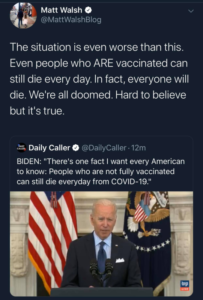
I feel for her. It must be invalidating and frustrating to be silenced and ignored by those vastly less informed than herself and the majority falling for their lies.

Tom's Blog on Life and Livingness

I feel for her. It must be invalidating and frustrating to be silenced and ignored by those vastly less informed than herself and the majority falling for their lies.

In a normal world, this would be a viral video. But this is 2021 and Big Tech has limited exposure of videos like these for fear that people might start asking more questions about the Covid vaccines.





Thomas E. Levy, MD, JD is a board-certified cardiologist and the author of Curing the Incurable: Vitamin C, Infectious Diseases, and Toxins and STOP America’s #1 Killer!; plus several other groundbreaking medical books.
He is one of the world’s leading vitamin C experts and frequently lectures to medical professionals all over the globe about the proper role of vitamin C and antioxidants in the treatment of a host of medical conditions and diseases.
His latest book, Rapid Virus Recovery: No Need to Live in Fear! is now available for FREE as an e-book through MedFox Publishing.
Dr. Levy states:
The entire intent of this book is to make it clear that nearly all acute viral syndromes are curable, especially those contracted via the respiratory route, and rapidly so. This includes COVID and any future pathogens that may emerge from mutation or from a laboratory.
That’s a pretty bold statement, but his book includes over 600 citations from peer-reviewed medical journals to back up his claim.
The book that he is offering to the public for free is mainly about hydrogen peroxide nebulization, an inexpensive solution that anyone around the world can implement without the use of a doctor or hospital for less than $40.00.
In order to stop any pandemic, COVID included, it is essential that a cure not only exists, but that it is extremely cheap, available everywhere, easily administered, completely nontoxic, and not requiring the intervention of a doctor or hospital in order to be obtained.
At this time, there is really only one such treatment that fulfills all of those requirements. It is: Hydrogen Peroxide Nebulization.
Download and save this book NOW before it is banned from the Internet, as the protocols described in it are now declared illegal.
Here are some excerpts from the Introduction to his book.
There is NO Need to be Afraid
Excerpts:
Acute viral infections have always presented a major challenge to the practitioners of traditional medicine. To this day, there exist no prescription agents that mainstream healthcare providers can utilize that have the ability to quickly and definitively cure a viral syndrome.
The most common and clinically severe of such viral infections are acquired via the respiratory route. When such viruses happen to be exceptionally contagious, the stage is set for the escalation of such infections to the level of an epidemic, or at its worst, a pandemic.
These common respiratory viral syndromes primarily fall into the broad array of viruses that cause the common cold and influenza (“flu”).
Depending on the strength of the immune system of the person infected, such an infection can be brief and self-limited, or it can be chronic and resistant to resolution.
Under some circumstances acute respiratory viral infections can quickly become life-threatening. The potentially fatal viral infections invariably evolve into influenza and influenza-like syndromes that disseminate throughout the body, causing generalized illness rather than the focal symptomatology seen with the typical nose and throat symptoms of a cold.
Nearly all acute viral syndromes are very responsive to a number of different treatment approaches, as will be discussed in this book.
Not only do most of these treatments work extremely well to lessen the severity and duration of the viral illness once it has taken hold, they also greatly enhance the body’s immunity against contracting a virus at all.
Some of the protocols that will be discussed can also quickly and unequivocally cure these infections in most patients.
The training of medical doctors makes them very reluctant to ever use the word “cure” in referring to the effectiveness of any treatment for any condition, no matter how effective such a treatment might actually be.
Indeed, just a cursory review of the medical literature on PubMed quickly reveals a common theme in the clinical studies.
No matter how profoundly clear-cut the studied treatments resolve various infections or medical conditions, the authors of such studies will NEVER assert that treatment X was able to cure condition, or infection, Y in the Results/Conclusion part of the study.
In fact, some of the most impressive studies will only assert that treatment X “appears” to be of benefit for condition Y, and that more studies are needed.
It’s as if there are certain unwritten commandments for all medical research scientists that require them to avoid any definitive statements — even when the results are glaringly clear.
The mantra of all research, especially clinical studies: Evaluate, measure, test, analyze, but never, never, never definitively conclude.
Researchers are similarly unwilling to report a clearly defined cause-and-effect relationship between two things, such as a treatment and a disease, or a medical condition and another disease.
Properly-dosed and properly-administered vitamin C has been curing nearly all acute infectious diseases, especially viral ones, for over 80 years now.
Many different articles have documented its benefits in this regard. Yet no current medical textbook even mentions vitamin C as a potential or possible treatment for infectious diseases.
While not a topic to be dealt with in any detail in this book, it must still be pointed out to the reader confused as to why vitamin C, or any other viral cure, is not widely used is revealed in the following sobering facts:
Healthcare is primarily a business.
Any commonly used agent/therapy must generate substantial and even unconscionable revenue for thepharmaceutical companies, the hospitals, and the physicians, or it will never be used or even properly investigated. More likely, it will be suppressed.
There is more politics in medicine than there is in politics.
Proof of these assertions abounds. For example, there was a total refusal by doctors and hospitals all over the United States to provide early treatment for the millions of Americans who tested positive for COVID but were told to “go home and only come back if having difficulty breathing.”
In other words, come back when the patient is so sick that they can admit him to the ICU and put him on a ventilator.
This “standard of care protocol” generated an automatic $39,000 check from the government as well as huge revenue for an intensive care hospital stay, and grossly inflated the fatality rate at the same time.
Many trusting patients simply cannot bring themselves to understand that their doctor or their hospital is much more interested in profits than their health interests and overall welfare. Certainly, there are exceptions to the blanket nature of these assertions.
But those exceptions are decidedly rare. Until the reader fully grasps the heinous truth of these assertions, it will remain impossible to understand why an easy and cheap answer to a grave infection or illness will always be disparaged, suppressed, and perhaps even made illegal.
(Editor’s note, it is now “illegal.” See: COVID Natural Remedies BANNED as DOJ and FTC Seek to Silence Doctors Promoting Vitamin D, C, Zinc, etc.)
Even many seemingly well-meaning physicians will almost reflexly reject and denigrate a therapy like HP nebulization, since it undercuts much of the significance of their many years of sacrifice, expense, and training in obtaining medical licenses.
Many different rationalizations can be used by doctors to not even consider HP nebulization as a therapy.
Nobody who has undergone extensive training in any field wants to feel that the huge amount of time and money invested may be irrelevant or even harmful in the treatment of a substantial number of their patients.
Imagine a physician with special ICU and respiratory medicine training, and most of the COVID patients that previously flooded the ICUs no longer appear.
How can he/she embrace an intervention that greatly reduces the number of people who needs their expertise and that threatens their ability to make a significant income — especially when the traditional medical community is loudly dismissing the intervention as being scientifically unfounded or even frankly fraudulent?
The entire intent of this book is to make it clear that nearly all acute viral syndromes are curable, especially those contracted via the respiratory route, and rapidly so.
This includes COVID and any future pathogens that may emerge from mutation or from a laboratory.
In order to stop any pandemic, COVID included, it is essential that a cure not only exists, but that it is extremely cheap, available everywhere, easily administered, completely nontoxic, and not requiring the intervention of a doctor or hospital in order to be obtained. At this time, there is really only one such treatment that fulfills all of those requirements. It is:
Hydrogen Peroxide Nebulization
The reasons why hydrogen peroxide (HP) nebulization is such a perfect therapy for any acute respiratory virus is detailed in the book, and does not need to be repeated here.
In extremely poor areas of the world, a nebulization machine, which still only involves a one-time expense of $30 to $40, can be shared by a household, or even a community that would use it at a local clinic or treatment center.
Treatment times need only last 5 to 15 minutes in most circumstances. A pint of regular 3% HP, to be used as is or with variable degrees of dilution with water or saline solution depending on patient tolerance, has a retail cost of 1 to 2 dollars throughout the planet.
The amount of HP for a treatment can be between 1 and 3 cc of the 3% solution. One pint has 473 cc of solution.
This means that a cure, or effective
kickstart to the rapid resolution of a respiratory virus, including COVID,
could cost as little as ¼ of a penny.
The amount of electricity needed to run the nebulizer, which would be inconsequential as well, would be the main “expense.”
It should also be emphasized that HP nebulization quickly and effectively resolves the common cold and all variety of influenza viral syndromes, depending on long how the patients have been infected when the nebulization is initiated.
It also means that ¼ of a penny can do what many extended hospitalizations costing many hundreds of thousands to millions of dollars do not do: heal the patient, spare the patient much suffering and possibly death, and permit the patient or family of the patient to avoid complete financial devastation.
Finally, there is another benefit as or even more significant as having the ability to cure oneself of this infection. Simply put:
Life can once again be lived without
continuously worrying about
loss of health, dealing with great
suffering, and even dying.
Very many people have become deathly afraid of contracting COVID, in spite of the fact that the mortality resulting from this infection has declined substantially, and is now on the order of one tenth of a percent (1 in 1,000).
Not only is the fear palpable, it is irrational.
For almost a year now, when stopping at a traffic light many drivers “socially distance” in their cars and maintain more than a car length from the cars ahead of them until the light changes.
Scientifically, this is ludicrous, but it does underscore the amount of fear that has been instilled in a very large number of people.
Some people are paralyzed with fear when they see someone’s mask drop below the nose for a moment as if the offender were an assassin. Some will literally attack such an individual.
Currently, the fear of the virus is much more debilitating to the population as a whole than the virus itself.
The information in the book demonstrates that a continued fear of COVID or any other respiratory virus is irrational.
Owning a good nebulizer and having a fresh bottle of HP readily at hand will keep COVID from destroying mental health before it has the chance to threaten physical health.
That means a return to normal life is possible, safe, rational, and easy to achieve.


Yet another article illustrating the link between vaccines and higher subsequent rates of infection and death. Those who had the flu vaccine are more likely to die from COVID.
https://articles.mercola.com/sites/articles/archive/2021/04/26/flu-vaccine-increases-covid-mortality.aspx